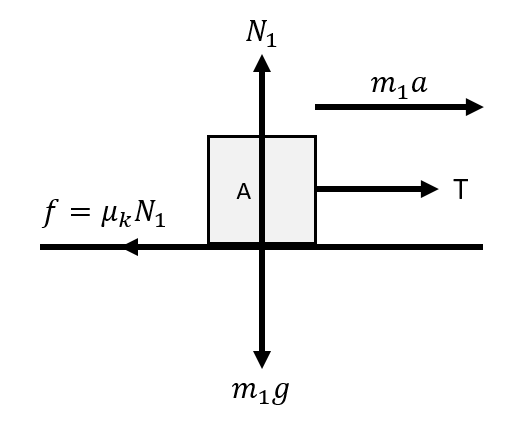
A block $A$ of mass ${{m}_{1}}$ rests on a horizontal table. A light string connected to it passes over a frictionless pulley at the edge of the table and from its other end, another block B of mass ${{m}_{2}}$ is suspended. The coefficient of kinetic friction between the block and the table is $\mu_k$. When block A is sliding on the table, the tension in the string is:
Answer
575.4k+ views
Hint: Since the friction between block A and the table is not sufficient, the block B moves down due to its weight and pulls the block A which is connected by a string. If the block B moves down with acceleration $a$, then block A will also move horizontally with the same acceleration $a$.
Complete step by step solution:

Here is the diagram of the block-pulley system as mentioned in the question. Now we will analyze the forces acting on each block from their free body diagram.
Free body diagram of block A

Here we see that the tension in the string pulls the block A of mass ${{m}_{1}}$ with an acceleration a. However, since the block is in contact with the table, it tries to pull the block backward due to kinetic frictional force $f$ between the block and the table. Therefore, if we balance the horizontal forces, we get
\[\begin{align}
& T-f={{m}_{1}}a \\
& T-{{\mu }_{k}}{{N}_{1}}={{m}_{1}}a \\
\end{align}\]
$\Rightarrow T-{{\mu }_{k}}{{m}_{1}}g={{m}_{1}}a$ ………. (1)
Here g is the acceleration due to gravity and ${{N}_{1}}$ is the normal reaction.
Free body diagram for block B

Here we see that block B of mass ${{m}_{2}}$ is pulled down by its weight with acceleration $a$ and the tension T in the string tries to pull the block upwards. Therefore, if we balance the vertical forces, we get
$\Rightarrow {{m}_{2}}g-T={{m}_{2}}a$ ………. (2)
Now adding equations 1 and 2 and solving for $a$, we get
\[\begin{align}
& \Rightarrow {{m}_{2}}g-{{\mu }_{k}}{{m}_{1}}g={{m}_{1}}a+{{m}_{2}}a \\
& \Rightarrow {{m}_{2}}g-{{\mu }_{k}}{{m}_{1}}g=({{m}_{1}}+{{m}_{2}})a \\
& \Rightarrow a=\dfrac{({{m}_{2}}-{{\mu }_{k}}{{m}_{1}})g}{{{m}_{1}}+{{m}_{2}}} \\
\end{align}\]
Substituting the value of $a$ in Eq. 2 and solving for T, we get
\[\begin{align}
& \Rightarrow {{m}_{2}}g-T={{m}_{2}}\dfrac{({{m}_{2}}-{{\mu }_{k}}{{m}_{1}})g}{{{m}_{1}}+{{m}_{2}}} \\
& \Rightarrow T={{m}_{2}}g-{{m}_{2}}\dfrac{({{m}_{2}}-{{\mu }_{k}}{{m}_{1}})g}{{{m}_{1}}+{{m}_{2}}} \\ \end{align}\]
On simplifying the above equation, we get
\[\begin{align}
& \Rightarrow T={{m}_{2}}g\left( 1-\dfrac{({{m}_{2}}-{{\mu }_{k}}{{m}_{1}})}{{{m}_{1}}+{{m}_{2}}} \right) \\
& \Rightarrow T={{m}_{2}}g\left( \dfrac{{{m}_{1}}+{{m}_{2}}-{{m}_{2}}+{{\mu }_{k}}{{m}_{1}}}{{{m}_{1}}+{{m}_{2}}} \right) \\ \end{align}\]
On further simplification, we get
\[\begin{align}
& \Rightarrow T={{m}_{2}}g\left( \dfrac{{{m}_{1}}+{{\mu }_{k}}{{m}_{1}}}{{{m}_{1}}+{{m}_{2}}} \right) \\
& \Rightarrow T=\dfrac{{{m}_{1}}{{m}_{2}}(1+{{\mu }_{k}})g}{{{m}_{1}}+{{m}_{2}}} \\
\end{align}\]
$\therefore$ The tension in the string when the block A is sliding is \[T=\dfrac{{{m}_{1}}{{m}_{2}}(1+{{\mu }_{k}})g}{{{m}_{1}}+{{m}_{2}}}\].
Note:
Suppose in this case, if the friction between block A and the table would have been sufficient to prevent the sliding of block A. In that case, there would be no motion by either block (i.e. $a=0$), and in the equations, the coefficient of kinetic friction $\mu_k$ would be replaced by the coefficient of static friction $\mu_s$.
Complete step by step solution:

Here is the diagram of the block-pulley system as mentioned in the question. Now we will analyze the forces acting on each block from their free body diagram.
Free body diagram of block A

Here we see that the tension in the string pulls the block A of mass ${{m}_{1}}$ with an acceleration a. However, since the block is in contact with the table, it tries to pull the block backward due to kinetic frictional force $f$ between the block and the table. Therefore, if we balance the horizontal forces, we get
\[\begin{align}
& T-f={{m}_{1}}a \\
& T-{{\mu }_{k}}{{N}_{1}}={{m}_{1}}a \\
\end{align}\]
$\Rightarrow T-{{\mu }_{k}}{{m}_{1}}g={{m}_{1}}a$ ………. (1)
Here g is the acceleration due to gravity and ${{N}_{1}}$ is the normal reaction.
Free body diagram for block B

Here we see that block B of mass ${{m}_{2}}$ is pulled down by its weight with acceleration $a$ and the tension T in the string tries to pull the block upwards. Therefore, if we balance the vertical forces, we get
$\Rightarrow {{m}_{2}}g-T={{m}_{2}}a$ ………. (2)
Now adding equations 1 and 2 and solving for $a$, we get
\[\begin{align}
& \Rightarrow {{m}_{2}}g-{{\mu }_{k}}{{m}_{1}}g={{m}_{1}}a+{{m}_{2}}a \\
& \Rightarrow {{m}_{2}}g-{{\mu }_{k}}{{m}_{1}}g=({{m}_{1}}+{{m}_{2}})a \\
& \Rightarrow a=\dfrac{({{m}_{2}}-{{\mu }_{k}}{{m}_{1}})g}{{{m}_{1}}+{{m}_{2}}} \\
\end{align}\]
Substituting the value of $a$ in Eq. 2 and solving for T, we get
\[\begin{align}
& \Rightarrow {{m}_{2}}g-T={{m}_{2}}\dfrac{({{m}_{2}}-{{\mu }_{k}}{{m}_{1}})g}{{{m}_{1}}+{{m}_{2}}} \\
& \Rightarrow T={{m}_{2}}g-{{m}_{2}}\dfrac{({{m}_{2}}-{{\mu }_{k}}{{m}_{1}})g}{{{m}_{1}}+{{m}_{2}}} \\ \end{align}\]
On simplifying the above equation, we get
\[\begin{align}
& \Rightarrow T={{m}_{2}}g\left( 1-\dfrac{({{m}_{2}}-{{\mu }_{k}}{{m}_{1}})}{{{m}_{1}}+{{m}_{2}}} \right) \\
& \Rightarrow T={{m}_{2}}g\left( \dfrac{{{m}_{1}}+{{m}_{2}}-{{m}_{2}}+{{\mu }_{k}}{{m}_{1}}}{{{m}_{1}}+{{m}_{2}}} \right) \\ \end{align}\]
On further simplification, we get
\[\begin{align}
& \Rightarrow T={{m}_{2}}g\left( \dfrac{{{m}_{1}}+{{\mu }_{k}}{{m}_{1}}}{{{m}_{1}}+{{m}_{2}}} \right) \\
& \Rightarrow T=\dfrac{{{m}_{1}}{{m}_{2}}(1+{{\mu }_{k}})g}{{{m}_{1}}+{{m}_{2}}} \\
\end{align}\]
$\therefore$ The tension in the string when the block A is sliding is \[T=\dfrac{{{m}_{1}}{{m}_{2}}(1+{{\mu }_{k}})g}{{{m}_{1}}+{{m}_{2}}}\].
Note:
Suppose in this case, if the friction between block A and the table would have been sufficient to prevent the sliding of block A. In that case, there would be no motion by either block (i.e. $a=0$), and in the equations, the coefficient of kinetic friction $\mu_k$ would be replaced by the coefficient of static friction $\mu_s$.
Recently Updated Pages
Master Class 11 Business Studies: Engaging Questions & Answers for Success

Master Class 11 Computer Science: Engaging Questions & Answers for Success

Master Class 11 Maths: Engaging Questions & Answers for Success

Master Class 11 Chemistry: Engaging Questions & Answers for Success

Master Class 11 Economics: Engaging Questions & Answers for Success

Master Class 11 Accountancy: Engaging Questions & Answers for Success

Trending doubts
What is meant by exothermic and endothermic reactions class 11 chemistry CBSE

10 examples of friction in our daily life

One Metric ton is equal to kg A 10000 B 1000 C 100 class 11 physics CBSE

1 Quintal is equal to a 110 kg b 10 kg c 100kg d 1000 class 11 physics CBSE

Difference Between Prokaryotic Cells and Eukaryotic Cells

What are Quantum numbers Explain the quantum number class 11 chemistry CBSE




